 资源简介
资源简介
期中考点全讲解
2024-2025学年译林版英语七年级下册
一、语音知识
1.国际音标核心体系
元音分类:
长元音(5个):/i:/(see)、/ɑ:/(car)、/ :/(door)、/ :/(food)、/ :/(girl);
短元音(7个):/ /(sit)、/ /(hot)、/ /(book)、/e/(bed)、/ /(cat)、/ /(cup)、/ /(about);
双元音(8个):/e /(play)、/a /(bike)、/ /(boy)、/ /(near)、/e /(bear)、/ /(sure)、/a /(house)、/ /(go)。
2.辅音发音规律:
清辅音(11个):/p/、/t/、/k/、/f/、/θ/、/s/、/ /、/h/、/t /、/ts/、/tr/;
浊辅音(17个):/b/、/d/、/g/、/v/、/ /、/z/、/ /、/r/、/d /、/dz/、/dr/、/m/、/n/、/ /、/l/、/w/、/j/。
3.字母组合特殊发音:
“ough”多音现象:though / /(虽然)、tough /t f/(艰难)、cough /k f/(咳嗽);
“wh”发音区别:when /wen/(清辅音)vs who /hu:/(浊辅音/h/)。
4.单词重音与音节划分
双音节词:重音多在首音节('letter, 'market),少数在次音节(a'bout, be'gin);
多音节词:重音标记规则(com'puter,preference),前缀后缀对重音的影响(un'happy,'national`)。
跟踪练习
1.根据音标写单词:
① / h sp tl/ __________ ② / mju z k/ __________ ③ / k nf d nt/ __________
④ / nt n n l/ __________ ⑤ / da t/ __________
⑥ / te bl/ __________ ⑦ / p r ɡr f/ __________ ⑧ / fju t / __________
2.选出划线部分发音不同的选项:
① A. think B. these C. three D. thank ( )
② A. each B. child C. chicken D. machine ( )
③ A. edited B. wanted C. needed D. played ( )
④ A. cold B. home C. love D. go ( )
⑤ A. sun B. same C. sure D. sit ( )
二、词汇与语法
考点1:冠词(U3核心语法)
1.不定冠词a/an的本质区别
判定依据:单词发音的第一个音素(非字母):
元音音素开头用an:an apple(/ pl/)、an umbrella(/ m brel /)、an hour(/ a /)、an honest man(/ n st/);
辅音音素开头用a:a university(/ ju n v s ti/)、a European country(/ j r pi n/)、a one-year plan(/w n/)。
特殊用法:a“一”表泛指(A boy is waiting for you),an表“一个”且强调元音音素开头。
2.定冠词the的六大用法
特指:The book on the desk is mine(指特定的书);
上文提及:I have a cat. The cat is black(第二次提到cat);
独一无二:the sun, the moon, the Earth;
序数词/最高级:the first lesson, the tallest building;
专有名词:the Great Wall, the West Lake, the United States;
形容词表类别:the rich(富人), the old(老人)。
3.零冠词的使用场景
专有名词:China, Beijing, Monday, Christmas;
抽象/物质名词:love, water, music, rice;
三餐/季节/球类:have breakfast, in spring, play basketball(但in the spring of 2024表特指);
复数名词表类别:Dogs are loyal animals.
跟踪练习
基础题
1.______ new library in our school is open from 9:00 a.m. to 5:00 p.m.
A. A B. An C. The D. /
2.She wants to be ______ engineer when she grows up, but her brother wants to be ______ artist.
A. a; an B. an; a C. an; an D. a; a
3.We usually have ______ dinner at home, but sometimes we go to ______ restaurant.
A. /; a B. a; / C. the; a D. /; the
进阶题
4. ______ 8-year-old girl named Lily won the painting competition.
A. A B. An C. The D. /
5. I have ______ uncle who works in ______ university located in ______ south of China.
A. an; a; the B. a; an; the C. an; an; / D. a; a; /
6. ______ harder you study, ______ better grades you will get.
A. The; the B. A; a C. /; the D. The; /
考点2:动词时态与固定搭配(U2/U4重点)
1.一般将来时三大结构
will + 动词原形:临时决定或未来事实(I will help you carry the box);
be going to + 动词原形:计划/打算(We are going to visit the museum next week)或迹象推测(Look at the clouds—it’s going to rain);
2.现在进行时表将来:仅限位移动词(come, go, leave, arrive等),如The train is leaving soon(火车即将出发)。
3.动词短语固定搭配陷阱
后接动名词(-ing):
enjoy doing(享受做)、mind doing(介意做)、finish doing(完成做)、practice doing(练习做)、look forward to doing(期待做)、have fun doing(做…有乐趣)、have trouble/difficulty (in) doing(做…有困难);
后接不定式(to do):
want to do(想要做)、decide to do(决定做)、plan to do(计划做)、hope to do(希望做)、offer to do(主动做)、refuse to do(拒绝做);
后接原形或ing意义不同:
see/watch/hear sb. do(全过程)vs see/watch/hear sb. doing(正在进行),如I saw him cross the road(全程)vs I saw him crossing the road(正在过马路)。
跟踪练习
基础题
1.They ______ (visit) the Summer Palace next Saturday.
2.Look! The children ______ (play) football on the playground.
3.If it ______ (not rain) tomorrow, we will have a picnic in the park.
进阶题
4. She can’t wait ______ (open) the gift from her best friend.
5. I remember ______ (meet) him at the library last month, but he doesn’t recognize me now.
6. The teacher told us ______ (not touch) the machine; it’s dangerous.
7. He spent two hours ______ (finish) his homework yesterday.
考点3:名词所有格与复数(U4语法重点)
1.名词复数规则与例外
规则变化:
一般加s:book→books, pen→pens;
以s/x/sh/ch结尾加es:bus→buses, box→boxes, dish→dishes, church→churches;
以辅音+y结尾变y为i加es:city→cities, family→families;
以f/fe结尾变f/fe为v加es:knife→knives, leaf→leaves(例外:roof→roofs, belief→beliefs)。
不规则变化:
单复同形:sheep→sheep, fish→fish, deer→deer;
特殊变化:child→children, man→men, woman→women, foot→feet, tooth→teeth。
2.所有格三大形式
’s所有格:
单数名词/不规则复数加’s:Tom’s book, the children’s toys;
规则复数(以s结尾)加’:the teachers’ office, the girls’ dormitory;
共同所有 vs 各自所有:Tom and Lucy’s house(共有的房子)vs Tom’s and Lucy’s houses(各自的房子)。
of所有格:
无生命事物或较长名词:the leg of the table, the name of the city;
时间/距离/国家:today’s news, ten minutes’ walk, China’s population。
双重所有格:
结构:a/an/this/that + 名词 + of + 名词性物主代词/名词所有格,如a friend of mine(我的一个朋友)、this book of Tom’s(汤姆的这本书)。
跟踪练习
基础题
1.There are three ______ (child) playing in the garden.
2.,The ______ (teacher) office is on the second floor of the building.
3.I bought two ______ (knife) for cooking.
进阶题
4. This is ______ (Lily and Lucy) bedroom; they share it together.
5. The ______ (postman) uniforms are blue, and they deliver letters every day.
6. I borrowed a dictionary from ______ (a friend of my father).
7. The ______ (leaf) on the trees turn yellow in autumn.
三、情景交际
1.邀请与回应高频句型
发出邀请:
Would you like to + 动词原形 (你想做…吗?)
How about/What about + 动名词 (做…怎么样?)
Why not + 动词原形 / Why don’t you + 动词原形 (为什么不…?)
Let’s + 动词原形!(我们一起…吧!)
接受邀请:
Yes, I’d love to. / That sounds great! / Good idea!
拒绝邀请:
I’m afraid not. / Sorry, I can’t. I have to... / Maybe another time.
2.情感表达与回应
安慰:Don’t worry. / Take it easy. / Everything will be fine.
祝贺:Congratulations! / Well done!
道歉回应:It’s OK. / Never mind. / Don’t mention it.
跟踪练习
基础题
1.—Would you like to come to my birthday party this Saturday
—______. I have to visit my grandparents.
A. Yes, I’d love to B. I’m afraid not C. Good idea D. That sounds great
2.—I passed the math exam!
—______! You’ve been working so hard.
A. Congratulations B. Good luck C. Don’t worry D. What a pity
进阶题
3. —______ go hiking in the mountains this weekend
—That’s a good idea. Let’s meet at 8:00 a.m.
A. Why not B. Would you like C. How about D. Let’s
4.—I’m sorry I broke your favorite cup.
—______. I can buy a new one.
A. You’re welcome B. Never mind C. Thank you D. That’s right
四、语法专题
专题1:基数词与序数词(U1重点)
1.基数词核心规则
拼写易错点:
forty(非fourty), eighty(非eightty), hundred/thousand/million(单数形式前有具体数字,如three hundred books);
复数形式用于模糊概念:hundreds of(成百上千), thousands of(成千上万)。
大数表达:
1,234 = one thousand two hundred and thirty-four;
10,567 = ten thousand five hundred and sixty-seven。
2.序数词变化规律
规则变化:基数词+th(如four→fourth, six→sixth);
不规则变化:
first(1st), second(2nd), third(3rd), fifth(5th), eighth(8th), ninth(9th), twelfth(12th);
整十变化:变y为ie加th(twenty→twentieth, thirty→thirtieth);
两位数变化:仅个位变序数词(twenty-first, thirty-second)。
跟踪练习
基础题
1.There are ______ (twelve) months in a year.
2.December is the ______ (twelve) month of the year.
3.He lives on the ______ (nine) floor of the building.
进阶题
4. The company was founded in the ______ (twenty) century.
5. She got the ______ (one) prize in the singing competition.
6. There are about five ______ (hundred) students in our school.
专题2:介词用法(U3方位与地点)
1.地点介词辨析
at/in/on:
at(小地点/具体位置):at the bus stop, at home;
in(大地点/内部):in Beijing, in the room;
on(表面/具体某天):on the desk, on Monday, on the wall。
2.方位介词:
in front of(外部前面)vs in the front of(内部前面):The car is in front of the house(车在房子外前面)vs The teacher is in the front of the classroom(老师在教室前部);
above(斜上方)vs over(正上方):The lamp is above the desk(灯在桌子上方)vs The bridge is over the river(桥在河正上方);
below(斜下方)vs under(正下方):The boat is below the bridge(船在桥下方)vs The cat is under the table(猫在桌子下)。
3.动态介词
across(表面穿过):cross the road = go across the road;
through(内部穿过):go through the forest;
along(沿着):walk along the river;
past(经过):pass by = go past。
跟踪练习
基础题
1.The bookstore is ______ the left side of the street.
2.We live ______ a small village ______ the mountains.
3.The cat is sleeping ______ the chair.
进阶题
4. The sun rises ______ the east and sets ______ the west.
5. She walked ______ the bridge and saw a beautiful view.
6. The temperature will be ______ zero tomorrow, so it won’t snow.
五、阅读与写作
阅读技巧与题型训练
细节题解题步骤
定位关键词:在题干中找到人名、地名、数字等定位词;
回文搜索:根据定位词在文中找到对应段落;
对比选项:选择与原文表述一致的选项(注意同义替换)。
推理题解题策略
逻辑推断:根据文中事实或情感色彩推断隐含意义;
排除法:排除与原文矛盾或未提及的选项。
阅读一:记叙文(人与社会·社区生活)
主题关联:Unit 2(社区志愿者)
阅读材料
Last Saturday, I joined a volunteer activity in our community. We cleaned the park, planted trees, and helped elderly people carry groceries. My friend Tom and I worked together to paint a mural on the community center wall. The mural shows children playing and smiling, which makes the whole building look brighter. After the activity, we had a picnic with all the volunteers. It was tiring but meaningful.
题目
1.What did the author do last Saturday
A. Visited a museum.
B. Played sports.
C. Joined a volunteer activity.
D. Studied at home.
2.Which of the following is NOT mentioned in the activity
A. Cleaning the park.
B. Planting trees.
C. Painting a mural.
D. Teaching English.
3.How did the author feel about the activity
A. Bored.
B. Tired but happy.
C. Sad.
D. Angry.
阅读二:说明文(人与社会·传统文化)
主题关联:Unit 4(中国民间艺术)
阅读材料
Dragon Boat Festival is a traditional Chinese holiday. It falls on the fifth day of the fifth lunar month. People eat zongzi and race dragon boats to remember the poet Qu Yuan. Zongzi is made of sticky rice, meat, and other ingredients wrapped in bamboo leaves. Dragon boat races are exciting, with teams paddling in rhythm to win. This festival is not only fun but also an important part of Chinese culture.
题目
1.When is Dragon Boat Festival celebrated
A. On the first day of the first lunar month.
B. On the fifth day of the fifth lunar month.
C. On the fifteenth day of the eighth lunar month.
D. On the tenth day of the tenth lunar month.
2.What do people eat during Dragon Boat Festival
A. Mooncakes.
B. Dumplings.
C. Zongzi.
D. Noodles.
3.Why do people race dragon boats
A. To have fun.
B. To exercise.
C. To remember Qu Yuan.
D. To celebrate the harvest.
阅读三:议论文(人与自我·科技影响)
主题关联:Unit 5(科技与生活)
阅读材料
Some people think smartphones are helpful, while others believe they cause problems. Smartphones allow us to stay connected with friends and family, get information quickly, and play games. However, too much screen time can lead to eye problems and less exercise. Students may also spend more time on phones than studying. In my opinion, smartphones are useful tools, but we should use them wisely.
题目
1.What is the main idea of the passage
A. Smartphones are completely good.
B. Smartphones are completely bad.
C. Smartphones have both advantages and disadvantages.
D. People should stop using smartphones.
2.What is a negative effect of smartphones
A. Staying connected with friends.
B. Getting information quickly.
C. Playing games.
D. Eye problems.
3.What does the author think about smartphones
A. They are useless.
B. They should be banned.
C. They are useful but need to be used wisely.
D. They are more harmful than helpful.
写作专题:家乡与传统文化
家乡类写作框架
开头:介绍家乡位置与总体印象;
主体:自然景观(如rivers, mountains)、人文特色(如local food, traditions)、个人经历(如favorite places, memories);
结尾:表达对家乡的热爱或邀请来访。
例句
My hometown, Suzhou, is a beautiful city in the south of Jiangsu. It is famous for its classical gardens and delicious food like Xiaolongbao. Walking along the old streets, you can see ancient bridges and rivers, which make the city look like a painting.
传统文化类写作要点
历史背景:介绍该文化的起源与发展(如paper-cutting has a history of over 1,500 years);
艺术特点:材料、形式、象征意义(如paper-cutting uses red paper and symbolizes good luck);
传承意义:呼吁保护(如We should learn and pass on traditional skills to keep our culture alive)。
例句
Chinese calligraphy is a unique art form with over 3,000 years of history. Using a brush and ink, artists create beautiful characters that show their personality and feelings. It is not only a writing skill but also a part of Chinese spirit.
答案与解析
一、语音知识跟踪练习答案
根据音标写单词:
① hospital ② music ③ confident ④ international ⑤ diet ⑥ table ⑦ paragraph ⑧ future
发音不同选项:
① B(/ /,其余/θ/) ② D(/ /,其余/t /) ③ D(/d/,其余/ d/) ④ C(/ /,其余/ /) ⑤ C(/ /,其余/s/)
二、冠词跟踪练习答案
1.C 2. C 3. A 4. B(8以元音音素/e /开头) 5. A(uncle元音开头用an,university辅音开头用a,the south表特指) 6. A(the+比较级,the+比较级:越…越…)
三、动词时态与固定搭配答案
W1.ill visit/are going to visit 2. are playing 3. doesn’t rain 4. to open(can’t wait to do固定搭配) 5. meeting(remember doing记得做过) 6. not to touch(tell sb. not to do) 7. finishing(spend time doing)
四、名词所有格与复数答案
1.children 2. teachers’ 3. knives 4. Lily and Lucy’s(共同所有) 5. postmen’s(复数所有格) 6. a friend of my father’s(双重所有格) 7. leaves
五、情景交际答案
1.B 2. A 3. A(Why not+动词原形) 4. B
六、语法专题答案
1.twelve 2. twelfth 3. ninth 4. twentieth 5. first 6. hundred
七、阅读例题答案
阅读一
C
D
B
阅读二
B
C
C
阅读三
C
D
C
展开更多......
收起↑
 资源预览
资源预览
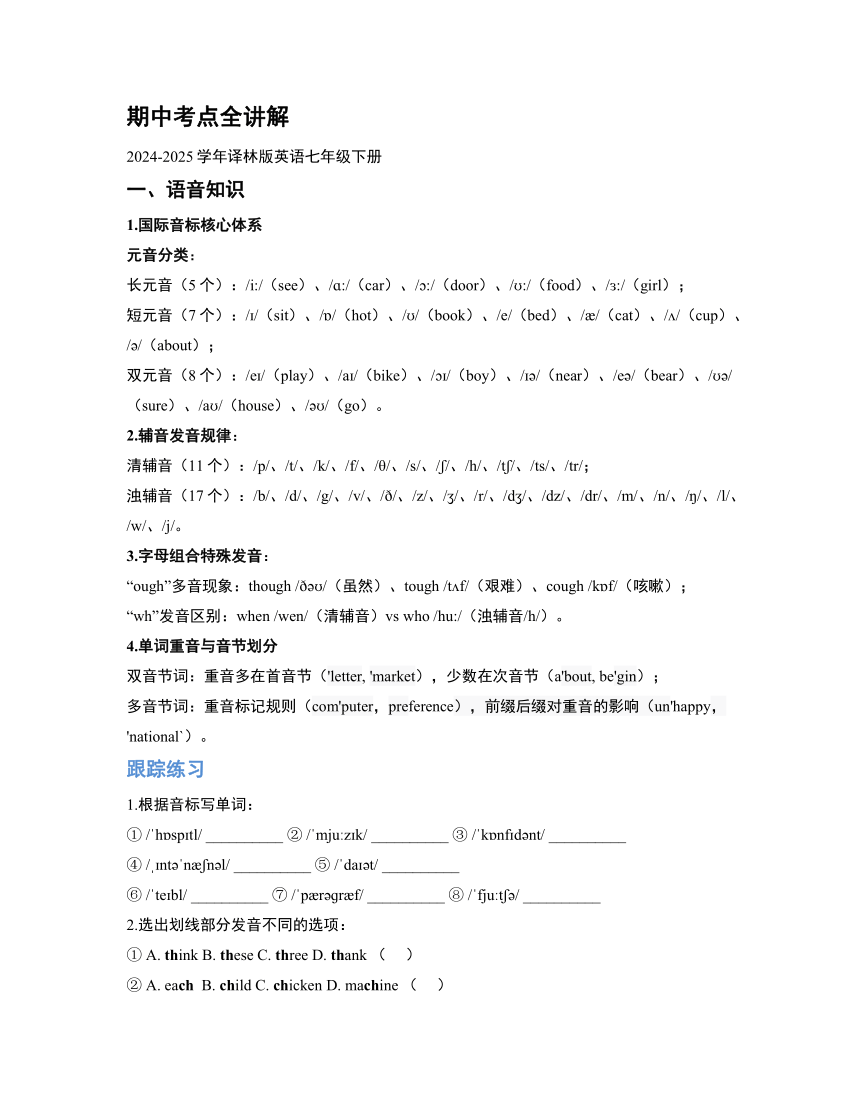
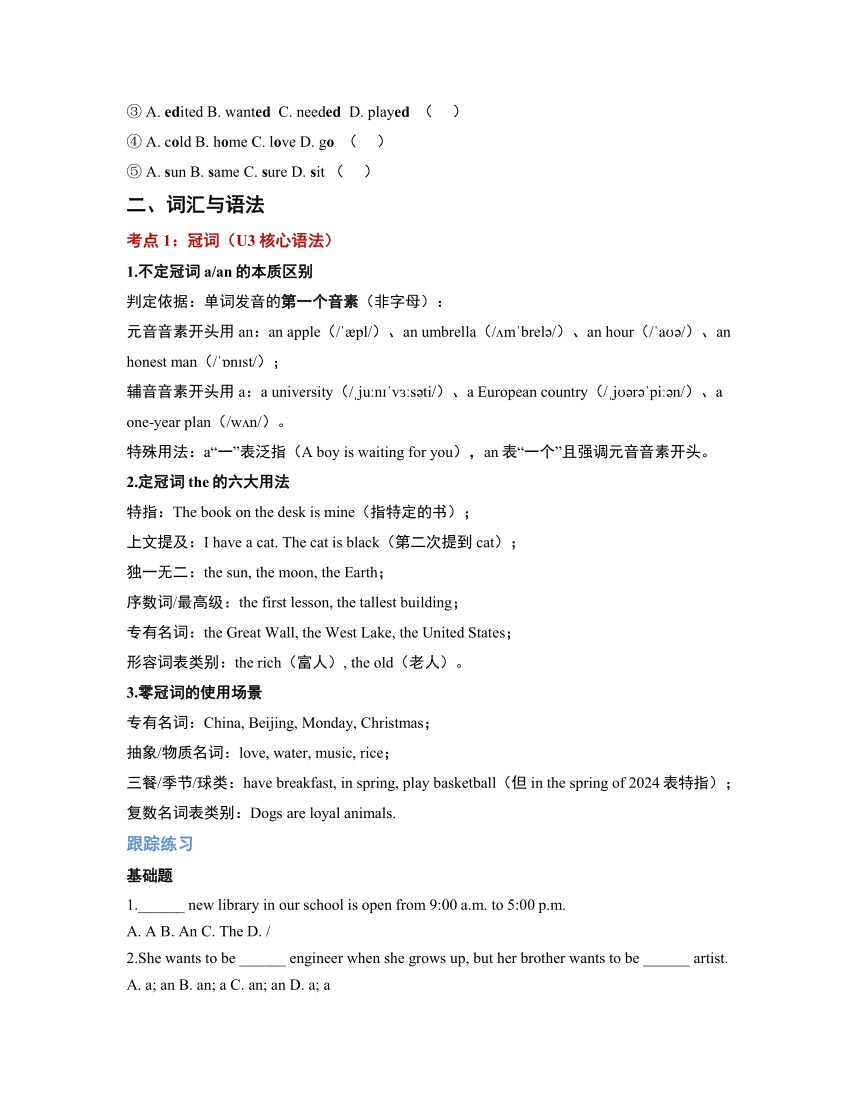
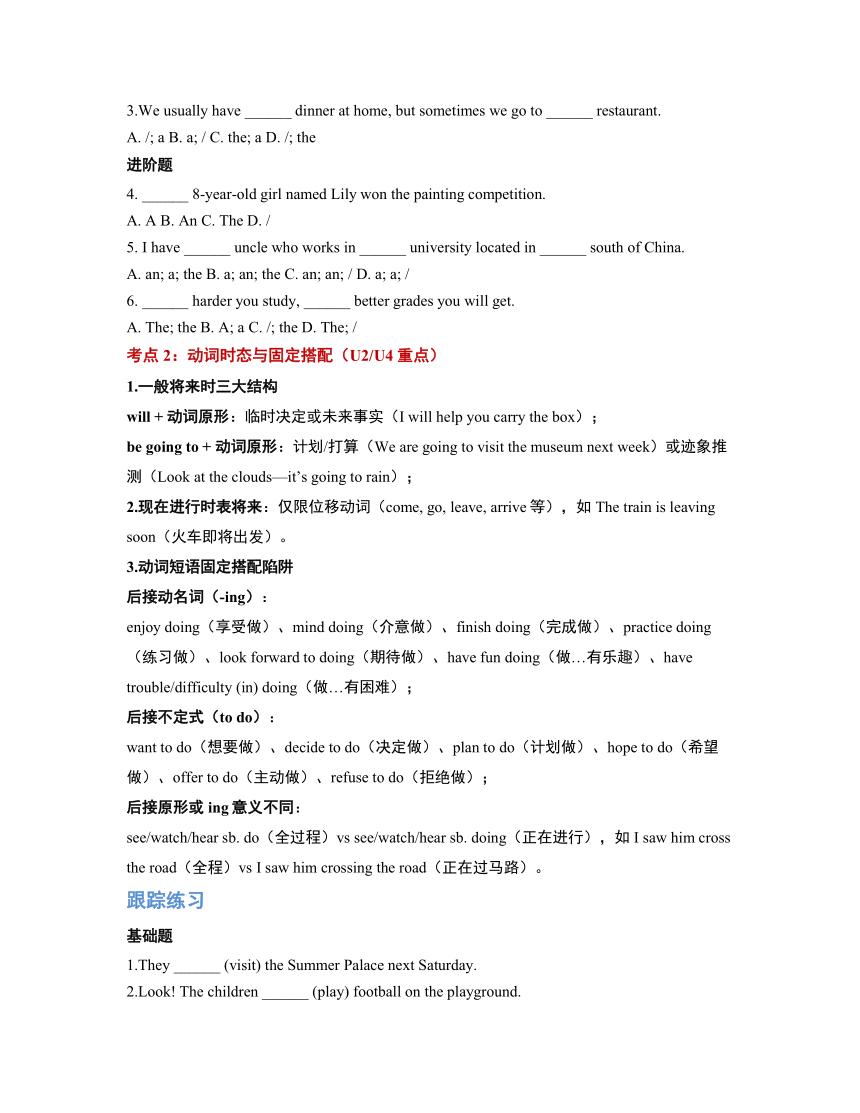
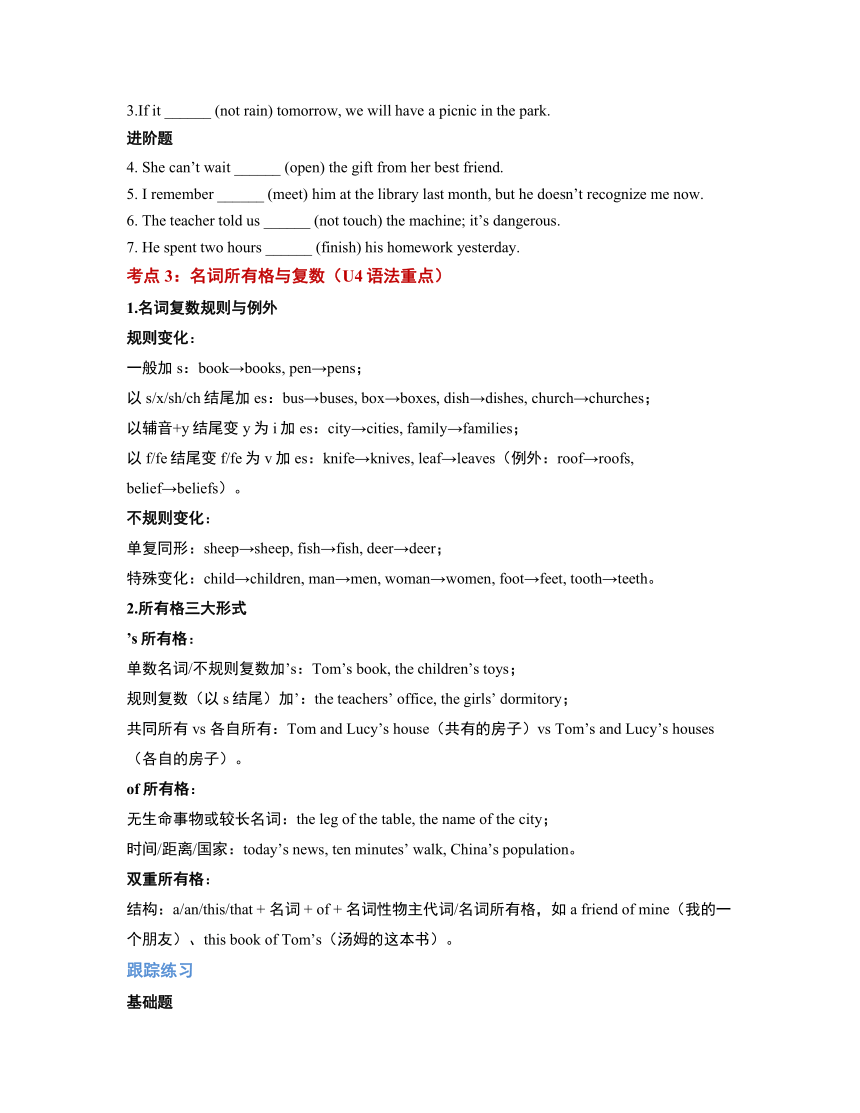
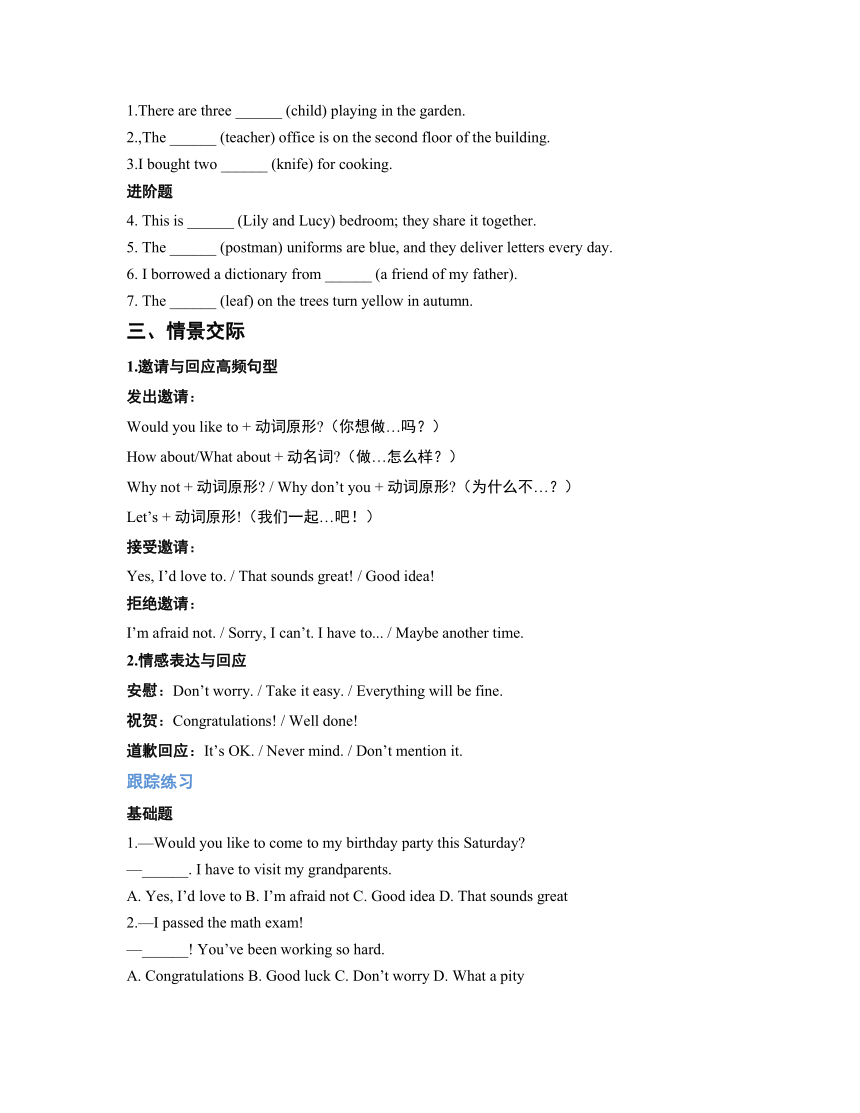
 资源预览
资源预览




